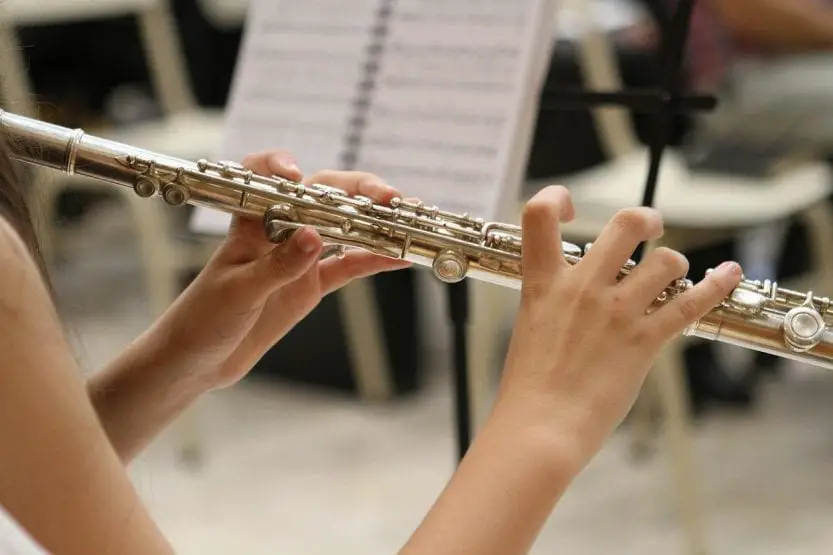Flute is a wonderful instrument, very popular in musical orchestra and bands. It is the only instrument which comes close to resembling a human voice. The flute has been around for thousands of years now. The modern flute is developed over many years. Before we begin our understanding of different types of flute let us discuss the history of flute.
History Of Flute
The earliest instance of flute dates way back to 2637 BC in China. Chinese historians talks about a cylindrical bamboo called “Tsche”. The Chinese version of flute had closed ends with an opening in the middle for blowing air.
Over the years, flutes have undergone many changes. Various materials such as brass, glass, ceramic and wood made flutes were developed to improve tone. Some tribes have even used flutes made up of human bones. With every design, the crude idea of the flute was further developed to include keys.
Additional tweaks made to enhance pitch and tone.
The modern flute was first developed in 1846 by German inventor Theobald Boehm. He was also a composer and flute player. Boehm experimented with the concept of tube. He tried out different variations by changing the size and positions of the tone-holes. The very first version of the modern flute consisted of a cylindrically shaped body. It had a parabolic structure with a head-joint tapered. Boehm had earlier tried his flute experiment with every conceivable material possible. The first flute he introduced to the world was in 1847. It was made up of silver and an alloy of nickel, zinc, and copper.
In the 1800s, the preferred choice of flute among players were the wooden ones. Even late into the 20th century, the wooden flute continued to dominate the market. The modern flute, developed in a short span of 50 odd years, took a while before eventually accepted by flute players.
How Difficult is it to Learn Flute?
Flute may feel difficult at first, but with dedicated practice and effort, it is like any other instrument. The flute with its soft tone resembles the human voice compared to all other forms of instrument. Flute being a wind instrument, require the practice of breathing aided exercises to improve stamina and technique.
It is important to develop a proper lip formation, also known as “embouchure”. A good trick to develop a playing technique would be to start with the “head joint”. The head joint enables players to produce sound without perfecting the lip formation. Meanwhile, players can practice finger movement while perfecting the lip formation.
It is common to feel dizzy during early days of flute practice. This is the fall out of heavy breathing to produce sound when lip formation is not developed. The dizziness would soon subside with time and practice. It is handy to have a chair nearby. Place your head between your knees till you feel better.
Another common hiccup when starting out with flute is difficulty to focus on fingers when blowing at the same. As flute is not a front held instrument, it can get difficult to control the lip formation, breathing and focus up on the finger movement. To make things easier, if another person can hold the flute in front, you can watch where the tone-holes are.

Types of Flute
Over the years, as metal flutes found acceptance by flutist world over, there were many types of flute that developed to cater to all. There are overall three types of flutes to choose from:
- Beginner Type Flute
- Intermediate Type Flute, and
- Professional Type Flute
Beginner Flute
The beginner range of flutes are specially made for students. They are easy to assemble. The focus is to make a flute which is affordable for all. The beginner flutes are priced low due to low labor effort and cheaper components. But not to say, there are some very well-made beginner flutes that can deliver very good sound.
The beginner flutes are made using brass for the tube along with a plating of silver on top. The silver provides better resonance over brass or nickel. Silver also provides better grip of the flute. A little higher end beginner flute would also include a lip plate made up of silver. This improves the overall tonal quality of the flute. There are various tonal versions available in beginner flutes such as offset G, split E and open/closed holes.
Intermediate Flute
The next range of flutes, priced a bit dearly, are the intermediate types. They are built using silver plates on the body and lip plate. There are few high-end intermediate flutes made up of complete silver in body, keys and head. The intermediate flutes are machine made and finished by hands. The hand finish provides a better depth in performance compared to beginner flutes. They are apt for those seeking to upgrade to a better flute under a budget.
Professional Flute
The professional flutes are the most expensive and the most premium. They are completely made by hand with the precision finish of expert artisans. Few machine-made components are used to save time and effort. The artisans making professional flutes are highly skilled, who have experience of making flutes for generations. The high cost of professional flutes are owed to skilled labor and world-class components.
The professional range of flutes are available in many options. They are available in pure silver, sterling silver or Britannia silver to the more rare ones made from platinum, gold or exotic wood.
Different Parts In A Flute
Head-Joint
It is an essential component in any flute. Flute players blows air into the head-joint that creates sound. The most common material used to manufactured head-joint are silver. There are also head-joints made of gold, nickel, wood and platinum. A head-joint also has the important pitch tuning element called tuning cork.
Body
The largest section of a flute is the body. It is the body which house the keys and it connects the head-joint with the foot-joint. The body is also the place where the sliding tuner and the tenons are placed. They are used in tuning the flute.
Foot-Joint
The foot-joint is the smallest part in a flute. The foot-joint contain the keys. The beginner level student flute would often come in standard C tuning foot-joint. It would have the C, C# and Eb key. The more high-end intermediate and professional type flute would be fitted with a B tuning foot joint. The B tuning feature extra keys towards the end.
Body Materials
Nickel and silver – They are alloys of nickel, zinc and copper, and are often used in beginner level flutes. The nickel Silver alloy posses lower density but a very resilient material which produce clear ad light tones.
Silver – Silver is the most commonly used body material for flutes. They produced very clear tones which are bright and light. The silver body flutes are heavier when compared to other body materials and preferred by intermediate to professional players. Silver is a high maintenance material and more suited for professionals.
Gold – Gold made flutes are highly prized flutes for the warmth and depth in tone. The gold is mixed with copper or silver to make it sturdy. The dark and warm tone of the gold body flutes makes it popular choice among professional flutists.
Different Plating Material Used In Flutes
Nickel – The most common for beginner flutes, the nickel plated flute feature a hard body, making cleaning and caring easier. They are also most lightweight in the category compared to other materials. Nickel plated body produce a crisp, warm and bright sound.
Silver – Silver plating material are slight heavier and produce a dark sound compared to nickel flutes. The silver material adds a bright finish which makes them attractive to look at. The high-end beginner along with intermediate and professional flutes use silver as a plating material.
Gold – Gold is mixed with other metals to make the plating sturdy. They make a high in depth and warm sound. Gold is a premium choice for professionals seeking a flute with a different tone. The gold also provides better handling for fast flute players. A popular choice among professionals, they are also priced higher than others.
Special Types Of Flute Keys
Offset G and Inline G
The most common form of key in flutes.
The Plateau Style Of Keys
Made for the beginner and intermediate, the finger technique is easier in plateau keys. They are common for student flutes and often mixed with an Offset G for easy access.
The French Styled Keys
The French style keys are also called as the open hole model of flute. The model feature a set of five different holes in the center of the flute. French styled keys produce a clear and loud sound as the air doesn’t get muffled. French styled keys come with an inline G to guide the left hand for student flute players.



